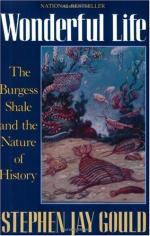|
This section contains 1,946 words (approx. 7 pages at 300 words per page) |

|
SOURCE: Smith, Wendy. Review of Wonderful Life, by Stephen Jay Gould. Publishers Weekly 236, no. 14 (13 October 1989): 32-3.
In the following review, Smith examines the commentary in Wonderful Life on the Burgess Shale rock formation, discovered in 1909 by paleontologist Charles Walcott, and his misinterpretation of the fossils within it.
It seems entirely appropriate that Stephen Jay Gould's office should be located in Harvard's Museum of Comparative Zoology, a red brick structure in the classic institutional style, built in 1859 by Louis Agassiz, America's premier 19th-century naturalist. Gould has devoted a good portion of his distinguished career to reminding us that science is an historical activity, concerned with explaining past events as well as discovering timeless laws, and that scientists are influenced by the cultural attitudes and prejudices of their age just like everyone else. Agassiz himself, as Gould revealed in an essay in Natural History magazine, was both a great scientist...
|
This section contains 1,946 words (approx. 7 pages at 300 words per page) |

|


